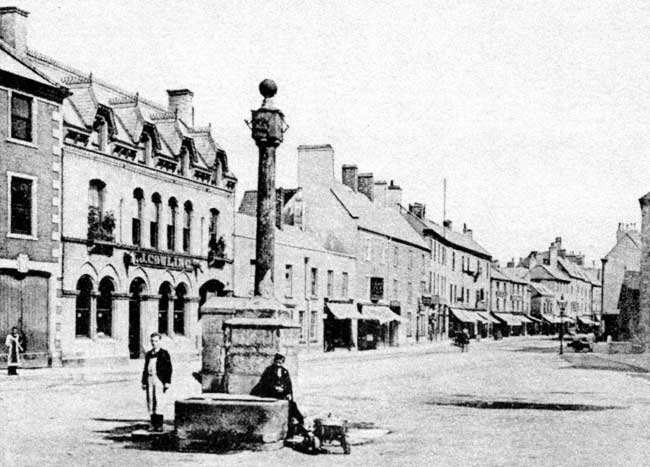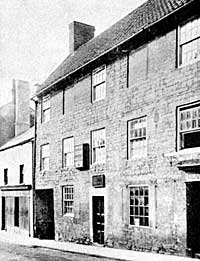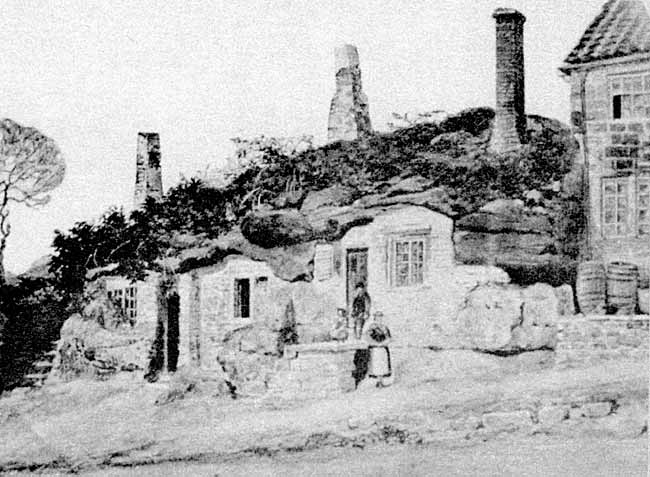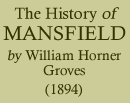< Previous | Contents | Next >
Antiquities of the Town and Neighbourhood
Toothill Lane.—One of the historic names in the town, that has descended without corruption since the earliest period of its existence, is "Toothill" Lane. This spot has derived its name from the fact of its having been the place, when the district was thickly wooded, where it was customary to place a night-watch, whose duty it was to blow a horn for the purpose of preventing the nocturnal depredations of the wolves. Sir Robert Plumpton, many generations ago, held a bovate of land in Mansfield Woodhouse—called Wolf Hunt Land—for the service of blowing a horn, and driving or frightening away the wolves in the Forest of Sherwood. In all probability there was a similar tenure in Mansfield, but the account of it has been lost. The ancient house at Mansfield Woodhouse still exists, and is known as "Wolf Hunt House" to this day.
Leeming Street.—The narrow street leading out of Mansfield to Warsop is called Leeming Street; and Thoroton says of it:—"It is remarkable that there are two other Roman roads so called: one in Essex; the other is well known in Yorkshire. 'Leeming,' it should be understood, is a British word, signifying a stony way —Lhe, a way; and mean, a stone. Great part of the road to Woodhouse is upon the rock." Another authority says Leem means a river, and ing a meadow, or the road through a meadow. In the case of Mansfield, however, this will not fit, as Leeming Street is too rocky for a meadow, and does not even lead to the river.
Curious Tenures.—In his "Old Nottinghamshire," Mr. J. Potter Briscoe gives a few curious tenures relating to this neighbourhood. He states that, after the Conquest, Gamelbere, an old Saxon knight, was allowed to retain two carucates of land at Cuckney (a village on the Poulter, near Worksop), for the service of shoeing the King's palfrey "as oft as he should be at his Manor at Mansfield"; and if he performed the work without injury to the Conqueror's palfrey, he was to receive a palfrey of the value of four marks; but if he lamed it, he was required to forfeit one of the same value.
At Sutton-in-Ashfield, near Mansfield, Jordan de Sutton once held land of the Crown by paying fourteen shillings yearly, besides rendering homage, suit, and service at the Mansfield Court every three weeks, and attending the King's army in Wales with one man and horse, and harbergeon, cap of iron, lance, and sword. Prior to 1339, the Manor of Kirkby-in-Ashfield was held by the payment of a yearly sum of forty shillings to buy wine, and six shillings and eightpence, or a quart of wheat at that price, to make wafers, to celebrate the Eucharist in the church of St. Mary, at Newstead.
The Old Bath.—Formerly, when the Forest existed in the neighbourhood in its glory, there used to be a holy well, dedicated to the Virgin Mary, in Bath Lane, as it is still called owing to the well being at the end. When Mr. White, of Sheffield, wrote his directory, about 1823, it was then used as a public bath. Mr. White, an old resident of Mansfield (over 80 years of age in 1891), told me that, when a boy, he used to go with his companions to bathe in this well. The water, however, was so cold that he was soon out again. There is a tradition that the well possesses certain valuable medicinal properties which, if now made public, might increase the importance of the town. The well, or spring, still exists in the grounds adjoining Mr. Goldie's mill, but its exact locality is known to only a few, and in a few years it will probably be forgotten. Mr. Harrod, in his history of the town, says: "Though I am not of the tribe of water drinkers, I had the curiosity to taste thereof, and pronounce it to be neither saline nor tepid." He, however, speaks very highly of the beauty of the approach to the bath. Near Mansfield Woodhouse there is another medicinal spring of chalybeate water, over which there was a building erected by Mr. Urban Hall. In all probability, the stream known as "Lady Brook" derived its name from sacred, or supposed sacred, associations; probably the Virgin Mary, after whom, in Catholic times, so many streams were named and invested with miraculous virtues.
Fairs and Markets.—Consequent upon the frequent visits of the old time kings to Mansfield, many privileges with regard to market rights and fairs, as well as to forestry, were granted to the inhabitants. Some of these have already been enumerated. The following is a copy of the exemplification of the grant of a fair to the town. It is copied from the Tower Records :— "Rex omnibus ad quos &c, salutem constat nobis per inspexionem rotulorum Cancellarie nostre q. nos nuper breve nostrum clausum fieri fecimus in hec verba Ricardus Dei Gratia Rex Anglie et Francie et Dominus Hiberno Vicscomti Nottingh. salutem quia ad supplicationem dilectorum nobis proborum hominam ville nostro de Mannesfield in Foresta nostra de Sherwod in comitatu predicto tenentium nostrorum volumas et habere ordinamus nobis Heredibus nostris imppetum quandam feriam singulis annis in eadem villa per quatuor dies duratur am videficet per duos dies proximo ante festum beatorum Petri et Pauli in Dio et crastino ejusdem Festi. Ita q. Feriailla non sit ad nouementum aliarum Feriarum vicinarum Tibi precipimus q. Feriamillam in singulis locis comitatis predicti ubi melius expedire videris publico proclari et teneri facias. Teste me ipso apud Wastminster tertio die Novembris anno regni nostri primo Nos autem tenorem brevis predicti ad requisitione tenentium nostrorum pre-dictiorum durimus exemplificandum per presentes In cuj. &c. Test."
The charter, of which the foregoing is a copy, was granted by King Richard for the holding of a fair on the eve of Saints Paul and Peter, after whom the parish church is named. The fair is still held. There are now two fairs held yearly—one in the month of July and the other in November. The former is a pleasure fair, and is observed as a holiday. The November fair is what is known as a statute fair for the hiring of servants. It was usual, in the past more than it is now, for the servant men and maids who were out of place to range themselves in rows, with a riband, or leaf, or other distinctive mark, to show they sought places. Farmers and housekeepers passed along the rows, making enquiries and examining appearances, until satisfied with someone, when a bargain was struck and ratified by an earnest shilling. This practice is fast dying out all over the country; and, when lads and lasses now walk into the fair, they have made their engagements beforehand, but will not forego the day's holiday, as it is one of their few opportunities of seeing friends and renewing acquaintances made in former situations.

Old Market Cross.
Mansfield Cross.—There is an old cross in Westgate, which is of undoubted antiquity, at which, in the past, the various kings and queens were proclaimed and all important announcements of a public character were made. Mr. Stapleton, the author of a valuable work on the "Crosses of Nottinghamshire," says:—"At a court held for the Manor of Mansfield, on the 5th August, 31st Elizabeth, in 1589, among lands surrendered for the use of the Grammar School was a parcel of land by William Sterne, lying in Mansfield, between the highway leading towards Ratcliffe Cross on the one side, and the close of William Sterne on the other. On the same occasion were surrendered High Cross Leys, in Mansfield. For a lease of twenty-one years, from Lady Day, 1830, four closes, called the High Cross Leys, or Bull Farm, containing 31 acres 3 roods 13 poles, were let to John Storey." It may be added that a Bull Farm is marked on the map about half way on the road to Pleasley. In a paper on "Mansfield and its Neighbourhood," read before the Lincoln Diocesan Society, at Mansfield, 23rd June, 1871, the Rev. R. H. Whitworth said that in Mansfield Market Place, on 31st March, 1603, "James the Sixth of Scotland was solemnly, at the Market Cross, proclaimed King of England by Sir John Byron, knight, Mr. Ayscoughe, high sheriff, Mr. Henry Chaworth, esquire, and Mr. George Chaworth, esquire." This is, in all probability, the cross which is now standing in the West Gate. "It seems curious," says Mr. Stapleton, "that neither this nor the erection at Woodhouse are mentioned by Harrod, whose 'History of Mansfield' appeared in 1801. It consists of a smooth, round, stone column, about a foot in diameter, surmounted by a large square stone and a ball. On each of the four sides of the square stone is a sun-dial. The shaft stands on a base of four square steps, part of which have been cut away on either side to accommodate a drinking fountain and a horse trough. Its height is about twelve feet." Some years ago, when the fair was held round this old cross, it was enclosed in Wombwell's wild-beast show. In putting up the canvas of the tent, the ball surmounting the cross was dislodged, and, falling on one of the workmen, killed him.

Residence of Mr Brunt.
An old "Manor" House.—An old, wrongly called, "Manor" house in Brunt Street, probably one of the oldest buildings in the town, possesses many ancient associations, but, unfortunately, its history has, to a certain extent, lapsed into oblivion. The quaint oak panelling of its rooms has been obscured by modern vandalism covering the carving with wall-paper; and the old tapestry with which it is hung, and which used to delight the connoisseur, has been allowed to fall to pieces. The house is now divided into tenements occupied by aged people, one of whom remembers the time when a picturesque garden was at the rear, approached by stone steps, and leading into the meadows, with a purling brook and a romantic looking bridge; but all this has been shut off by a high wall. Before it was occupied as it is now, the old house answered the purpose of a school, where the youngsters played pranks with the schoolmaster, and when shut in, as they frequently were, amused themselves, it is stated, by breaking the windows with a poker. Many years ago, a somewhat remarkable discovery was made, showing that the ancient occupants were people of position and wealth. A person named Randall went to visit one of the poor residents of the place, and observed him cutting with difficulty what appeared to be a piece of hard wood, out of which he said he was trying to make a cribbage board. Randall examined the wood, and, struck by its uncommon appearance, offered to give the man a piece more suitable for the purpose and more easily worked. An exchange was effected with mutual satisfaction, and Randall discovered that the piece of hard wood was nothing less than a very handsome ivory crucifix, which was afterwards proved to be the work of a celebrated Italian sculptor. The crucifix was subsequently sold to a wealthy resident, who still has it in his possession, for £100. If the old manor house could, only be properly examined, a mine of wealth might be discovered by the intelligent explorer. As it is, there is every probability that what remains may be destroyed by dry rot, the moths, and the worm. The tapestry is rapidly falling to pieces, and in a few years more will be absolutely worthless. Several offers have been made to purchase the work, but all have been declined. The house has recently been purchased by Mr. J. Witham, together with the tapestry.
Cromwell House.—No. 30, West Gate, known as Cromwell House, probably derives its name from the fact that it was at one time the residence of Mr. John Cromwell, the ejected minister of Claworth. He formerly resided at Newark, but, upon the passing of the Five Mile Act, removed to Mansfield, where, from the same cause, was a considerable colony of Nonconformist ministers. Mr. Cromwell died at his native place, Barnby Moor, about April, 1685. The house, however, is an exceedingly ancient structure, and, in the absence of evidence to the contrary, may be classed amongst those erected during the troublous period—1534 to 1538. Its interior walls are built double, and contain hiding-places, where those who were the objects of pursuit or persecution might be kept concealed securely from their foes. These secret chambers, I believe, exist to the present day; and a resident, Mr. Ball, has assured me he well remembers playing in these passages when a boy, until forbidden to do so by his parents. The house was occupied at the beginning of the century as a high-class seminary for boys, the principal being the Rev. Samuel Catlow. In those days there was a big space in front of the house, used as a fish pond, the only memorial of which is the tree railed off nearly opposite Cromwell House. This house is at present in the occupation of Mr. Downham, draper. The back part is used as offices by Mr. Bryan, solicitor.

Rock Houses.
The Rock Houses.—No visitor to Mansfield thinks of returning home without visiting these wonderful excavations in the sandstone, and which, until lately, provided homes for a large number of people, chiefly besom-makers. Indeed, there is one, the best of them all, still occupied. They are situated at the top of Ratcliffe Gate, near to the Reindeer Inn. Their origin is shrouded in impenetrable mystery. Harrod makes no mention of them, and the only reference to these houses by old writers I have come across is in Thoroton's "History of Nottinghamshire." He states that "the entrance here is the counterpart of Sneinton, near Nottingham; for, as in that place, here are several dwellings in this cut out of the sandy rock, and the chimnies of the habitations standing above the surface of the earth made through the rock." There are living hundreds of Mansfieldians who, as lads, used to find their way to the fields at the back for the purpose of throwing stones down the chimneys. There are old legends that assert these places are of the same age as those at Nottingham, and that, when the Forest existed in all its glory, they were used as homes for the outlaws—in short, that Robin Hood and his merry men occupied them. The work of excavating is of a very rude character, and was done without much labour, owing to the crumbling nature of the sandstone. My own opinion is that these places are many hundred years old, and were made by squatters, who saw an easy means of escaping rent and possessing comfortable apartments into the bargain. The example of one would be followed by others, and so we get the little colony of broom-makers who formerly resided here, and were no doubt quite as happy as their neighbours in well-built brick and stone houses. However, the houses are there. Previous to the enclosure of 1850, when the property passed into the possession of the late Mr. Richard Watson, the houses at the top of the rock were occupied by Joseph Freeman, sen., Joseph Freeman, jun., Geo. Freeman, and Joseph Freeman, besom-makers; J. Dixon, and Paulson. The lower ones were occupied by squatters:—George Bingley, William Chamberlain, Charles Hobson, William Briggs, John Briggs, Thomas Gilbert, Richard Claytons, Charles Cooper and Wells, George Gilbert, William Gilbert, John Cooke, Mary Bowskill, James Gilbert, Mary Byron, Samuel Hayes, Richard Hibbert, Sarah Clarke, Ashmore, John Greenwood, Robert Massey, Elizabeth Watson, and Mary Shea. Only one of these houses, as has been stated, is still occupied, and that by a man named Bramwell, who has converted what was formerly the stack-yard of the besom-makers into a little paradise in the way of gardens. He says he has always heard the houses spoken of as being six hundred years old at the least; and certainly they have not been made within one hundred or so years, as some assert to suit their own convenience. Close by formerly lived old Molly Ashmore, who, nearly three quarters of a century ago, kept a school for children in a tiny house still standing. As one who is strongly in favour of the preservation of ancient landmarks and monuments, I consider these relics of the past should become public property—by gift, if possible; if not, by purchase—and some effort made to prevent them crumbling entirely away.
